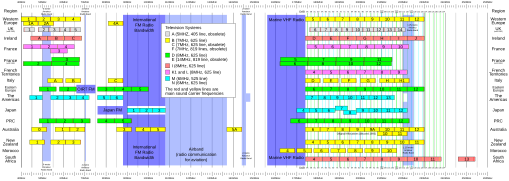
CCIR System M,[1][2][3] sometimes called 525–line, monochrome NTSC, NTSC-M, or CCIR-M,[4][5] is the analog broadcast television system approved by the FCC (upon recommendation by the National Television Systems Committee - NTSC)[6] for use in the United States since July 1, 1941,[7][8] replacing the 441-line TV system introduced in 1938.[8] System M comprises a total of 525 interlaced lines of video, of which 486 contain the image information, at 30 frames per second. Video is amplitude modulated and audio is frequency modulated, with a total bandwidth of 6 MHz for each channel, including a guard band.[9]
It was also adopted in the Americas and Caribbean; Myanmar, Philippines, South Korea, Taiwan and Japan (here with minor differences, informally referred to as System J). System M doesn't specify a color system, but NTSC (NTSC-M) was normally used, with some exceptions: NTSC-J in Japan, PAL-M in Brazil and SECAM-M in Cambodia, Laos and Vietnam (see Color standards section below).
The letter M designation was attributed by the ITU at the 1961 Stockholm meeting (see ITU identification scheme).[10]
In 1965, Thailand decided to replace System M with 625-line CCIR System B which started in 1967 and adopted PAL in the same year. [11]
Since 2015, System M is being replaced by digital broadcasting, in countries such as the Americas, Japan, South Korea, Taiwan and the Philippines.


